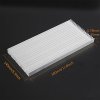Mass is definitely a factor.
Sorry, I understood what you meant, it was just a technicality. I have seen other posts of yours and I know you know what you are talking about. Technically even though it's not relevant to a heatsink, in thermal dynamics mass is typically used to calculate the time it takes for the temperature to change. Example how long will it take for an aluminum object with with a mass of M to change from a temperature of T
1 to T
2 with an ambient temperature of T
a. Or how long will it take an ice cube with a mass of M to melt in a volume V of water at temperature T.
For a heatsink mass would be a factor in how much time it would take for the heatsink to reach steady state thermal equilibrium.
Given the thermal dynamic formulas use length width and height for a material with a specific thermal resistance, mass is NOT a factor. If one dimension was unknown and the material was known (e.g.), then the missing dimension could be calculated from the mass. Still the mass is not directly relevant.
one was 2x as dense....the "L" is increased.
Not necessarily. Density may affect the thermal resistance. And if the mass was 2X it would depend on where the new mass came from, like was it added to the fins, or the base or both.
See how long that 90C j-C temp lasts...
My guess would be a millisecond as the temperature quickly rises from ambient past 90°C on it way to a much higher temperature. Keeping a 100W CoB cool is very difficult to do economically. I would use water cooling.








